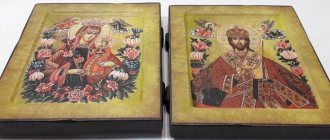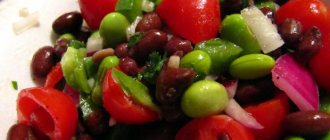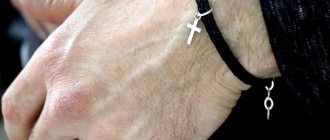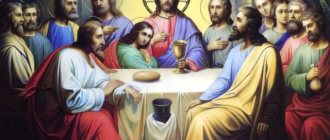Orthodox Life
Priest Andrei Chizhenko answers.
The Orthodox Church has always confessed that during the Eucharist bread, wine and water actually turn into the Body and Blood of Christ. This faith has been professed by the holy fathers from ancient times to the present day. So, for example, Saint John Chrysostom wrote in his work “The Sacrament of the Chalice of Christ”: “This Blood cleansed the inaccessible place and the Holy of Holies. If her image had such power in the Jewish temple, and in Egypt, when the doorposts were anointed with blood, then the truth itself is much more so. This Blood consecrated the golden altar. Without her, the bishop did not dare to enter an inaccessible place. This Blood supplied the priest. She washed away sins in images. If she had such power in images, if death was so afraid of the shadow, then tell me, can she not be afraid of the truth itself? This Blood is the salvation of our souls. The soul is washed by it. It makes our soul purer than gold. This Blood poured out made heaven accessible to us.”
By images the saint means Old Testament prototypes of the atoning sacrifice of Christ. Under the truth is the New Testament Eucharist, when during the liturgy earthly material matter is physically transformed by the grace of the Holy Spirit into the Body and Blood of Christ, given under the guise of wine and bread.
More than a thousand years later, the holy righteous John of Kronstadt will write in his diaries, which will be formed into the beautiful spiritual work “My Life in Christ”: “With undoubted faith, partaking of the life-giving Mysteries, I tangibly learn from the omnipresence of Christ. How? Like this: in every particle of the body and in every drop of blood I accept the whole Christ and, thus, I see with the eyes of my heart that He is at the same time complete in all particles and drops, no matter how many there are, to infinity.”
And also there: “What is amazing that bread and wine are the body and blood of Christ and Christ rests in them as the soul in the body?.. Also: if the devil can give spirit and speech to an animal icon (Apoc. 13:15), then how can Christ not dwell in bread and wine and not transform them and not completely assimilate them to Himself, like flesh and blood?”
This dogma was proclaimed at the Council of Constantinople in 1691, chaired by the Patriarchs of Constantinople Callinicus II and Dositheos II of Jerusalem. The conciliar charter (tomos) sets out the Orthodox teaching about the essential change of bread and wine into the Body and Blood of the Lord in the real presence of Christ in the Eucharist. For this, the patristic terms “transition” and “transubstantiation” are used.
This is why the reverence of priests and Orthodox laity at the Liturgy is so great. So, for example, in the ritual manual for clergy called “Teaching News,” which is a set of rules primarily for the preparation and service of the Divine Liturgy, it is said: “If a particle of the Divine Blood drips through the negligence of a serving priest, he will sin mortally. If it drips on the board, let him lick it off with his tongue; if this is impossible, let him wipe it with a sponge, then plan the board, burn the shavings on a brick or on a clean stone, and bury the ashes under the throne.” There are many similar rules in the Uchichesky News.
Based on all of the above, we see what a terrible shrine appears before us, for us and in us at every Divine Liturgy, and with what reverence and fear we must approach it. We must purify ourselves with God's help to the necessary extent with which we can accept into ourselves nothing less than the Body and Blood of Christ themselves. As the Holy Chief Apostle Paul said about the Eucharist: “For whoever eats and drinks unworthily, he eats and drinks condemnation for himself, without considering the Body of the Lord. That is why many of you are weak and sick, and many are dying” (1 Cor. 11:29,30). The apostle said this about contemporary cases of neglect of the Holy Mysteries, and it remained a warning for all generations and times.
Therefore, approaching the Chalice, we fold our hands crosswise (right over left on the chest) so that the palms touch the shoulders. In this way, we show humility and fear of God and at the same time deprive our hands of the vain opportunity to make unnecessary movements that threaten to knock the Cup or spoon out of the hands of the clergyman. We place our chin on top of the plate held by the deacon or sexton, so that the plate covers our clothes - so that if suddenly, God forbid, a drop of blood drips, it would happen in the plate, and not on your clothes or on the floor.
After this, we say our name and open our mouth wide, without trying to do anything with our tongue, so as not to push a piece of the Body out of the spoon or mouth. When the priest places the spoon in our mouth, we need to swallow a piece. After this, wait until the deacon or sexton wipes our lips with the cloth, and then gratefully kiss the Chalice in the priest’s hand. But under no circumstances should you use the priest’s hand, because it holds the Holy Chalice; you must not shake it or make unnecessary movements near the Chalice.
Then, without talking or opening our mouths, without kissing the icons, we go to the drinking table, where the clergyman pours us warm water mixed with wine. We drink the drink - it is advisable to rinse your mouth with it and then swallow the liquid to make sure that the Body and Blood of Christ have passed from the mouth to the stomach. Then you should eat a piece of the offered prosphora. After this, you can kiss the icons, the holy cross, and talk.
Let us, dear brothers and sisters, approach the Body and Blood of Christ with great reverence and fear of God. They are our life. They are our salvation. Our task is to approach them with dignity: with fasting, having undergone the Sacrament of Confession, with reading the necessary prayers and canons, and having made peace with everyone. And, of course, with great love for God – our Father and for people.
Saint John Chrysostom, in his book “The Sacrament of the Chalice of Christ,” wrote a unique call from the Lord to us: “I wanted to be your brother; For your sake I have partaken of flesh and blood; and this flesh and blood, through which I became related to you, I again teach you. This Blood gives us a blooming and royal appearance, gives birth to indescribable beauty, does not allow the nobility of the soul to fade, constantly watering and nourishing it. Our blood, formed from food, does not immediately become blood, but first becomes something else; but this Blood is not like that, but it immediately waters the soul and imparts to it some great power. This Blood, received with dignity, removes and drives demons far away from us, and calls angels and the Lord to us. Demons flee from where they see the Lord's blood, and angels flock there. Shed on the cross, this Blood washed the entire universe.”
Priest Andrey Chizhenko
“To the question: answers of Orthodox priests to Christians”
Question: “More than once I have observed how people after communion come up for a drink the same way as if they were going to communion with their arms crossed on their chests. Is this right or wrong? After all, it's just drinking. If I'm wrong, correct me."
Priest Maxim Kaskun answers: “If we talk about the mechanism of action, the result is the following: when a person approaches the Chalice, he folds his arms crosswise on his chest. Why is he doing this? To express a feeling of reverence. When he approaches the drink, his arms are crossed, not because he feels reverence for the drink, but in this way he maintains the reverence that he received when receiving the Holy Mysteries of Christ.
— I think that many people don’t even understand what drinking is.
— In principle, there may not be any drinking. The most important thing is that a person eats holy bread after communion, so that the crumbs that remain in the mouth are completely consumed by the body. And drinking water appeared as a help in this regard. Therefore, today, it differs in its composition in different places: where jam is added, where it is diluted with wine, somewhere some kind of compote is made. It’s better, of course, to dilute it with wine.
— It happens that people who do not receive communion want to grab a drink, is this acceptable?
- I think it’s acceptable. In this case, drinking water will act as reinforcement. As at the all-night vigil, we eat bread, which we consecrate at the litia, and then we consecrate the wine and moisten the bread with this wine; in fact, we drink it with this wine at the altar. In ancient times, it was like reinforcement at all-night vigils, long vigils that began in the evening and ended in the morning. And after eating this bread, people also received communion. Today there is a practice at night Christmas services, when this bread is given; in some churches it is held in the hands and eaten after communion. And in some temples, which is more correct and according to ancient custom, it is eaten immediately as a reinforcement. Sometimes another question arises: How to distinguish between the antidor and the consecrated bread that we eat at litia. Of course, these are different things, antidor in translation means “instead of a gift” - this is the bread that remains from the taken out Lamb, if we talk about the degrees of holiness, then the holiest after communion. And that’s why it is given to those who do not receive communion, “instead of a gift,” and that’s the meaning of it. But traditionally it happened that a person who has not taken communion can only eat prosphora. And in principle, it is not forbidden to eat antidor.
Is it possible to replace Cahors with compote?
Category: Old site > Society. 09/05/2012. G.
In some churches in Dnepropetrovsk, after communion, believers are given compotes and sweet liqueurs instead of water for the prosphora.
What is this “innovation”? We want to wash down the holy prosphora with plain water or Cahors! Valentina.
Dear Valentina, why do you think that the difference in drinking after communion is an “innovation”? What does it mean to “wash down the holy prosphora with plain water or Cahors”? On the other hand, I don’t understand why inflate a problem where it does not and cannot exist, and what does it mean: “we want”? I will try to explain the origin and practical significance of drinking after Holy Communion. The tradition of drinking after communion has the same ancient origins as the communion itself. And it is needed so that after receiving the Holy Mysteries of Christ, not even the slightest crumb of the Body of Christ remains in the mouth of the communicant. Therefore, the most ordinary water is suitable for this purpose. As for compotes, sweet liqueurs or wine drink (red dessert sweet wine diluted with water), this is also practiced in different places, in different churches and there is no statutory prohibition on this matter. For example, in the territory of Ancient Rus', the drink usually served as a warm drink made from berries - berry juice or jam. But on Athos, drinking wine is not practiced, but holy water is used. Who invented the wine drink, I’m afraid, will remain a mystery even for the most meticulous church historian, but what kind of drink to drink after communion - alcoholic or non-alcoholic - is, I think, not a fundamental question, and in each church this issue is resolved in its own way. By the way, it is useful for everyone to remember the words of Blessed Augustine, whom church tradition calls the “Teacher of Grace”: “Unity is in the main, freedom in the secondary, love in everything.” It should also be noted that the concepts “Cahors” and “church wine” are not synonymous. Church wine can be represented only by Cahors or Benicarlo, as well as a mixture of them. However, not every Cahors wine can be used as church wine. For example, an old high-quality Cahors, whose color is dominated by bulbous brick tones, when diluted with water, will not be able to meet the requirements of church wine in this regard. And the most important thing! It is regrettable when a person participating in the sacraments of the Holy Church, partaking of the Holy Mysteries of Christ, immediately after receiving them begins to reflect on such miserable and insignificant things in the Divine Liturgy as “drinking.” The “Sacrament of the Sacraments” of the Orthodox Church is the Holy Eucharist. She is the core of the Church, its foundation, the foundation, without which the existence of the Church is unthinkable. In Communion, the Lord Himself enters into us, He becomes one body and one blood with us, His Body becomes our body, His Blood becomes our blood. When we receive communion, we take into ourselves not only Christ under the guise of bread and wine, but the entire gospel law, all the moral, spiritual and other norms contained in the gospel. Having accepted the Holy Mysteries into yourself, it is necessary to carry them within yourself with dignity, with caution, with reverence, just as the Most Holy Theotokos carried the infant Christ in Her womb. Only then will communion of the Holy Mysteries of Christ help us, having been renewed spiritually and physically, to unite with God, because only life in God can satisfy us and fill life with joy and perfection. And finally, one more piece of advice to the rigoristic and conservative believers, whom St. Gregory the Theologian called “some of our excessively Orthodox.” In the Church of Christ there is always a place for diversity, and no matter how strange it may sound - even differences of opinion, in accordance with Scripture: “...There must be differences of opinion among you, so that those who are skilled may be revealed among you” (1 Cor. 11:18). But the Church has never been and cannot be divided into “liberals” and “conservatives.” In the Church there is a division between those who believe and confess that Christ has given us absolute freedom, and those who place the petty regulation of every step of a Christian above everything in the world, above love, above hope, above faith, above works of mercy.
PARTICIPLE
What is Communion? - This is the Sacrament in which, under the guise of bread and wine, an Orthodox Christian partakes (partakes) of the very Body and Blood of the Lord Jesus Christ for the forgiveness of sins and eternal life, and through this is mysteriously united with Him, becoming a partaker of eternal life. Comprehension of this Sacrament surpasses human understanding. This Sacrament is called the Eucharist, which means “thanksgiving.” How and why was the Sacrament of Communion established? — The Sacrament of Communion was established by the Lord Jesus Christ Himself at the Last Supper with the Apostles on the eve of His suffering. He took bread into His Most Pure hands, blessed it, broke it and divided it to His disciples, saying: “Come, eat: this is My Body” (Matthew 26:26). Then he took a cup of wine, blessed it and, giving it to the disciples, said: “Drink from it, all of you, for this is My Blood of the New Testament, which is shed for many for the remission of sins” (Matthew 26:27-28). Then the Savior gave the apostles, and through them all believers, the commandment to perform this Sacrament until the end of the world in remembrance of His suffering, death and Resurrection for the unity of believers with Him. He said, “Do this in remembrance of Me” (Luke 22:19).
Why is it necessary to take communion? — The Lord Himself speaks about the obligatory nature of communion for all who believe in Him: “Truly, truly, I say to you, unless you eat the Flesh of the Son of Man and drink His Blood, you will not have life in you. He who eats My Flesh and drinks My Blood has eternal life, and I will raise him up on the last day. For My Flesh is truly food, and My Blood is truly drink. He who eats My Flesh and drinks My Blood abides in Me, and I in him” (John 6:53-56). He who does not partake of the Holy Mysteries deprives himself of the source of life - Christ, and places himself outside of Him. A person who seeks union with God in his life can hope that he will be with Him in eternity.
How to prepare for Communion? — Anyone who wishes to receive communion must have heartfelt repentance, humility, and a firm intention to improve. It takes several days to prepare for the Sacrament of Communion. These days they prepare for Confession, try to pray more and more diligently at home, and abstain from amusements and idle pastimes. Fasting is combined with prayer - bodily abstinence from light food and marital relations. On the eve of the day of Communion or in the morning before the Liturgy, you must go to confession and attend the evening service. After midnight, do not eat or drink. The duration of preparation, the measure of fasting and prayer rules are discussed with the priest. However, no matter how much we prepare for Communion, we cannot adequately prepare. And only looking at the contrite and humble heart, the Lord, out of His love, accepts us into His fellowship.
What prayers should you use to prepare for Communion? — For prayerful preparation for Communion, there is a usual rule, which is found in Orthodox prayer books. It consists of reading three canons: the canon of repentance to the Lord Jesus Christ, the canon of prayer to the Most Holy Theotokos, the canon to the Guardian Angel and the Follow-up to Holy Communion, which consists of the canon and prayers. In the evening you should also read prayers for the coming sleep, and in the morning - morning prayers. With the blessing of the confessor, this prayer rule before Communion can be reduced, increased, or replaced by another.
How to approach Communion? — Before the start of Communion, those receiving communion come closer to the pulpit in advance, so as not to rush later and not create inconvenience to other worshipers. In this case, it is necessary to let the children who receive communion first go ahead. When the Royal Doors open and the deacon comes out with the Holy Chalice with the exclamation: “Come with the fear of God and faith,” you should, if possible, bow to the ground and fold your arms crosswise on your chest (right over left). When approaching the Holy Chalice and in front of the Chalice, do not cross yourself, so as not to accidentally push It. One must approach the Holy Chalice with the fear of God and reverence. Approaching the Chalice, you should clearly pronounce your Christian name given at Baptism, open your lips wide, reverently, with the consciousness of the holiness of the Great Sacrament, accept the Holy Gifts and immediately swallow. Then kiss the base of the Chalice, like the rib of Christ Himself. You cannot touch the Chalice with your hands and kiss the priest’s hand. Then you should go to the table with warmth and wash down Communion so that the holy thing does not remain in your mouth.
How often should you take communion? — Many holy fathers call for communion as often as possible. Typically, believers confess and receive communion during all four multi-day fasts of the church year, on the twelfth, great and temple holidays, on Sundays, on their name days and births, and spouses on their wedding day. The frequency of a Christian's participation in the Sacrament of Communion is determined individually with the blessing of the confessor. More commonly - at least twice a month.
Are we sinners worthy to receive communion often? — Some Christians receive communion extremely rarely, citing their unworthiness as the reason. There is not a single person on earth worthy of Communion of the Holy Mysteries of Christ. No matter how much a person tries to purify himself before God, he will still not be worthy of accepting such a greatest Shrine as the Body and Blood of the Lord Jesus Christ. God gave people the Holy Mysteries of Christ not according to their dignity, but out of His great mercy and love for His fallen creation. “It is not the healthy who need a physician, but the sick” (Luke 5:31). A Christian should accept the Holy Gifts not as a reward for his spiritual deeds, but as a Gift from the Loving Heavenly Father, as a saving means of sanctifying the soul and body.
Is it possible to take communion several times on one day? - No one and under no circumstances should receive communion twice on the same day. If the Holy Gifts are given from several Chalice, they can only be received from one.
Everyone receives communion from the same spoon, is it possible to get sick? — There has never been a single case of someone becoming infected through Communion: even when people receive communion in hospital churches, no one ever gets sick. After Communion of believers, the remaining Holy Gifts are consumed by a priest or deacon, but even during epidemics they do not get sick. This is the greatest Sacrament of the Church, given, among other things, for the healing of soul and body.
Is it possible to kiss the cross after Communion? — After the Liturgy, all those praying venerate the cross: both those who received communion and those who did not.
Is it possible to kiss icons and the priest’s hand after Communion and bow to the ground? — After Communion, before drinking, you should refrain from kissing icons and the priest’s hand, but there is no rule that those receiving communion should not kiss icons or the priest’s hand on this day and not bow to the ground. It is important to keep your tongue, thoughts and heart from all evil.
How to behave on the day of Communion? — The Day of Communion is a special day in the life of a Christian, when he is mysteriously united with Christ. On the day of Holy Communion, one should behave reverently and decorously, so as not to offend the shrine with one’s actions. Thank the Lord for the great blessing. These days should be spent as great holidays, devoting them as much as possible to concentration and spiritual work.
Can you take communion on any day? - Communion is given on all days when the Divine Liturgy is served. Liturgy is not served on Friday during Holy Week. During Lent, services are held according to a special schedule.
Is Communion paid for? — No, in all churches the Sacrament of Communion is always performed free of charge.
Is it possible to receive communion after Unction without Confession? — Unction does not cancel Confession. Confession is needed. Sins that a person is aware of must necessarily be confessed.
Is it possible to replace Communion by drinking Epiphany water with artos (or antidor)? — This erroneous opinion about the possibility of replacing Communion with Epiphany water with artos (or antidor) arose, perhaps, due to the fact that people who have canonical or other obstacles to Communion of the Holy Mysteries are allowed to drink Epiphany water with antidor for consolation. However, this cannot be understood as an equivalent replacement. Communion cannot be replaced by anything. Can an Orthodox Christian take communion in any non-Orthodox church? — No, only in the Orthodox Church.
How to give communion to a one-year-old child? — If a child is not able to remain calmly in the church for the entire service, then he can be brought to the time of Communion.
Is it possible for a child under 7 years old to eat before Communion? Is it possible for sick people to receive communion without an empty stomach? — This issue is resolved individually in consultation with a priest. Before Communion, young children are given food and drink as needed, so as not to cause damage to their nervous system and physical health. Older children, from the age of 4-5, are gradually accustomed to the usual fasting before Communion and, in general, to an “adult” diet and life. In some exceptional cases, adults are blessed to receive communion without an empty stomach.
Can children under 14 years of age receive communion without Confession? — Without Confession, only children under 7 years old can receive communion. From the age of 7, children receive communion after Confession.
Is it possible for a pregnant woman to receive communion? - Can. It is advisable for pregnant women to partake of the Holy Mysteries of Christ more often, preparing for Communion through repentance, confession, prayer and fasting, which is relaxed for pregnant women. It is advisable to begin the churching of a child from the moment the parents find out that they will have a child. Even in the womb, the child perceives everything that happens to the mother and around her. At this time, participation in the Sacraments and prayer of parents is very important.
How to give communion to a sick person at home? — The patient’s relatives must first agree with the priest about the time of Communion and consult on how to prepare the patient for this Sacrament.
When can you receive communion during the week of Lent? — During the period of Great Lent, children receive communion on Saturdays and Sundays, when the Liturgy of St. Basil the Great is served. Adults, except Saturday and Sunday, can receive communion on Wednesdays and Fridays, when the Liturgy of the Presanctified Gifts is served. There is no Liturgy on Monday, Tuesday and Thursday during Lent, with the exception of the days of remembrance of certain saints.
Why are infants not given communion at the Liturgy of the Presanctified Gifts? — At the Liturgy of the Presanctified Gifts, the Chalice contains only blessed wine, and the particles of the Lamb (the Bread transposed into the Body of Christ) are pre-saturated with the Blood of Christ. Since infants, due to their physiology, cannot be given communion with a part of the Body, and there is no Blood in the Chalice, they are not given communion during the Presanctified Liturgy.
Can the laity receive communion during the continuous week? How should they prepare for communion at this time? Can a priest prohibit communion on Easter? In preparation for communion during the continuous week, it is allowed to eat fast food. At this time, preparation for communion consists of repentance, reconciliation with neighbors and reading the prayer rule for Communion. Communion on Easter is the goal and joy of every Orthodox Christian. The entire Holy Pentecost prepares us for communion on Easter night: “let us be led to repentance, and let us purify our feelings, against which we fight, creating the entrance to fasting: the heart is aware of the hope of grace, not worthless, not walking in them. And the Lamb of God will be carried away by us, in the sacred and luminous night of the Resurrection, for our sake the slaughter brought, the disciple received on the evening of the sacrament, and the darkness destroying ignorance with the light of his resurrection” (stichera on the verse, on the Meat Week in the evening). Rev. Nicodemus the Holy Mountain says: “those who, although they fast before Easter, do not receive communion on Easter, such people do not celebrate Easter... because these people do not have in themselves the reason and occasion for the holiday, which is the Sweetest Jesus Christ, and do not have that spiritual joy that is born from Divine Communion." When Christians began to shy away from communion on Holy Week, the fathers of the Trullo Council (the so-called Fifth-Sixth Council) with the 66th canon testified to the original tradition: “from the holy day of the Resurrection of Christ our God until the new week, throughout the entire week, the faithful must holy churches to continually practice psalms and chants and spiritual songs, rejoicing and triumphant in Christ, and listening to the reading of the Divine Scriptures, and enjoying the holy mysteries. For in this way we will be resurrected together with Christ and ascended.” Thus, communion on Easter, on Holy Week, and in general on continuous weeks is not forbidden to any Orthodox Christian who may be admitted to Holy Communion on other days of the church year.
What are the rules for prayerful preparation for communion? The scope of the prayer rule before communion is not regulated by the canons of the Church. For the children of the Russian Orthodox Church, it should be no less than the Rule for Holy Communion available in our prayer books, which includes three psalms, a canon and prayers before communion. There is, in addition, a pious tradition of reading three canons and an akathist before receiving the Holy Mysteries of Christ: the canon of repentance to our Lord Jesus Christ, the canon to the Mother of God, the canon to the Guardian Angel.
Is confession necessary before every communion? Mandatory confession before communion is not regulated by the canons of the Church. Confession before each communion is a Russian tradition, caused by the extremely rare communion of Christians during the synodal period of the history of the Russian Church. For those who came for the first time or with serious sins, for new Christians, confession before communion is mandatory, since for them frequent confession and the instructions of the priest have important catechetical and pastoral significance. At present, “regular confession should be encouraged, but not every believer should be required to confess without fail before every communion. By agreement with the confessor, for persons who regularly confess and receive communion, observe church rules and fasts established by the Church, an individual rhythm of confession and communion can be established” (Metropolitan Hilarion (Alfeev)).
LiveInternetLiveInternet
The Orthodox Church has always confessed that during the Eucharist bread, wine and water actually turn into the Body and Blood of Christ.
This faith has been professed by the holy fathers from ancient times to the present day. So, for example, Saint John Chrysostom wrote in his work “The Sacrament of the Chalice of Christ”: “This Blood cleansed the inaccessible place and the Holy of Holies. If her image had such power in the Jewish temple, and in Egypt, when the doorposts were anointed with blood, then the truth itself is much more so. This Blood consecrated the golden altar. Without her, the bishop did not dare to enter an inaccessible place. This Blood supplied the priest. She washed away sins in images. If she had such power in images, if death was so afraid of the shadow, then tell me, can she not be afraid of the truth itself? This Blood is the salvation of our souls. The soul is washed by it. It makes our soul purer than gold. This Blood poured out made heaven accessible to us.”
By images the saint means Old Testament prototypes of the atoning sacrifice of Christ. Under the truth is the New Testament Eucharist, when during the liturgy earthly material matter is physically transformed by the grace of the Holy Spirit into the Body and Blood of Christ, given under the guise of wine and bread.
More than a thousand years later, the holy righteous John of Kronstadt will write in his diaries, which will be formed into the beautiful spiritual work “My Life in Christ”: “With undoubted faith, partaking of the life-giving Mysteries, I tangibly learn from the omnipresence of Christ. How? Like this: in every particle of the body and in every drop of blood I accept the whole Christ and, thus, I see with the eyes of my heart that He is at the same time complete in all particles and drops, no matter how many there are, to infinity.”
And also there: “What is amazing that bread and wine are the body and blood of Christ and Christ rests in them as the soul in the body?.. Also: if the devil can give spirit and speech to an animal icon (Apoc. 13:15), then how can Christ not dwell in bread and wine and not transform them and not completely assimilate them to Himself, like flesh and blood?”
This dogma was proclaimed at the Council of Constantinople in 1691, chaired by the Patriarchs of Constantinople Callinicus II and Dositheos II of Jerusalem. The conciliar charter (tomos) sets out the Orthodox teaching about the essential change of bread and wine into the Body and Blood of the Lord in the real presence of Christ in the Eucharist. For this, the patristic terms “transition” and “transubstantiation” are used.
This is why the reverence of priests and Orthodox laity at the Liturgy is so great. So, for example, in the ritual manual for clergy called “Teaching News,” which is a set of rules primarily for the preparation and service of the Divine Liturgy, it is said: “If a particle of the Divine Blood drips through the negligence of a serving priest, he will sin mortally. If it drips on the board, let him lick it off with his tongue; if this is impossible, let him wipe it with a sponge, then plan the board, burn the shavings on a brick or on a clean stone, and bury the ashes under the throne.” There are many similar rules in the Uchichesky News.
Based on all of the above, we see what a terrible shrine appears before us, for us and in us at every Divine Liturgy, and with what reverence and fear we must approach it. We must purify ourselves with God's help to the necessary extent with which we can accept into ourselves nothing less than the Body and Blood of Christ themselves. As the Holy Chief Apostle Paul said about the Eucharist: “For whoever eats and drinks unworthily, he eats and drinks condemnation for himself, without considering the Body of the Lord. That is why many of you are weak and sick, and many are dying” (1 Cor. 11:29,30). The apostle said this about contemporary cases of neglect of the Holy Mysteries, and it remained a warning for all generations and times.
Therefore, approaching the Chalice, we fold our hands crosswise (right over left on the chest) so that the palms touch the shoulders. In this way, we show humility and fear of God and at the same time deprive our hands of the vain opportunity to make unnecessary movements that threaten to knock the Cup or spoon out of the hands of the clergyman. We place our chin on top of the plate held by the deacon or sexton, so that the plate covers our clothes - so that if suddenly, God forbid, a drop of blood drips, it would happen in the plate, and not on your clothes or on the floor.
After this, we say our name and open our mouth wide, without trying to do anything with our tongue, so as not to push a piece of the Body out of the spoon or mouth. When the priest places the spoon in our mouth, we need to swallow a piece. After this, wait until the deacon or sexton wipes our lips with the cloth, and then gratefully kiss the Chalice in the priest’s hand. But under no circumstances should you use the priest’s hand, because it holds the Holy Chalice; you must not shake it or make unnecessary movements near the Chalice.
Then, without talking or opening our mouths, without kissing the icons, we go to the drinking table, where the clergyman pours us warm water mixed with wine. We drink the drink - it is advisable to rinse your mouth with it and then swallow the liquid to make sure that the Body and Blood of Christ have passed from the mouth to the stomach. Then you should eat a piece of the offered prosphora. After this, you can kiss the icons, the holy cross, and talk.
Let us, dear brothers and sisters, approach the Body and Blood of Christ with great reverence and fear of God. They are our life. They are our salvation. Our task is to approach them with dignity: with fasting, having undergone the Sacrament of Confession, with reading the necessary prayers and canons, and having made peace with everyone. And, of course, with great love for God – our Father and for people.
Saint John Chrysostom, in his book “The Sacrament of the Chalice of Christ,” wrote a unique call from the Lord to us: “I wanted to be your brother; For your sake I have partaken of flesh and blood; and this flesh and blood, through which I became related to you, I again teach you. This Blood gives us a blooming and royal appearance, gives birth to indescribable beauty, does not allow the nobility of the soul to fade, constantly watering and nourishing it. Our blood, formed from food, does not immediately become blood, but first becomes something else; but this Blood is not like that, but it immediately waters the soul and imparts to it some great power. This Blood, received with dignity, removes and drives demons far away from us, and calls angels and the Lord to us. Demons flee from where they see the Lord's blood, and angels flock there. Shed on the cross, this Blood washed the entire universe.”
Priest Andrey Chizhenko, Orthodox Life
https://pravoslavie.fm/interested/pochemu-posle-pr...vku-i-syest-kusochek-prosfory/










